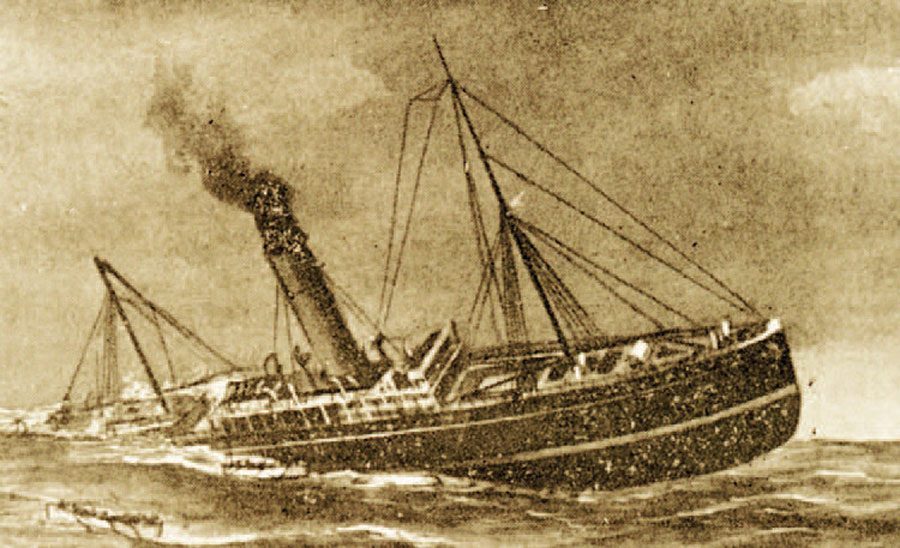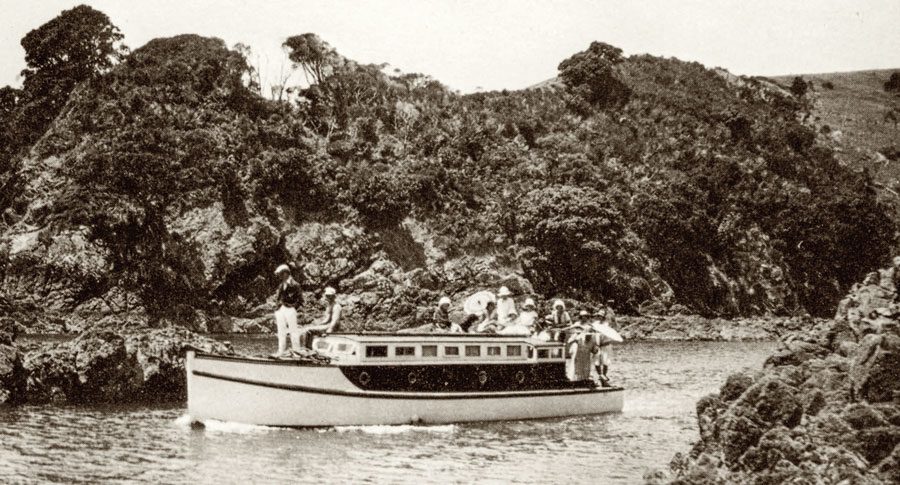

Harry Reginald Jenkins was a prominent Auckland businessman, launch owner and yachtsman for 30 years from 1916.

Harry was born in Eltham, Taranaki, in 1881, the third son of a pioneer farming family. His first experience of the sea in small boats was on a trip to Kapiti Island from Waikanae around 1893 with his uncle Frank in a dinghy borrowed from a local fisherman. Frank rowed the six miles while Harry bailed with a rusty fruit tin. It was calm at first, but the wind picked up and Harry was busy with the bailer.
They stayed on the north end of the island with his uncle’s friend, Mr Lowe and helped him build a 30ft boat to be used as a lighter to carry Lowe’s sheep out to steamers. In his memoirs, Harry wrote, “Adze, axe and hand-saw were the principal tools. Much of the timber was driftwood from shipwrecks, mainland sawmills, or some jetty or bridge that had been washed out to sea by flood or high tide. The aroma of red lead, pitch and tar, the ping-ping of the caulking hammer, the heaving of ropes through block and tackle, were new experiences.”
This sojourn on Kapiti left an indelible impression on Harry. Back in Eltham, he made his first boat by hollowing out a log for a canoe that he messed about in on nearby Lake Rotokare.
Once dairy factories and creameries were established in Taranaki, Harry’s father turned to dairy farming. Instead of the uncertainty and seasonal income from wool and cattle sales, dairying provided a regular monthly income. It was highly labour-intensive as the cows had to be milked by hand, the milk separated by the new Swedish-built Alfa Laval separator, and the cream transported to the local dairy factory by horse and wagon. The labour often came from the farmer’s children.
On his marriage to Dot White in 1906 he received ‘Dovedale’ at Maata, a dairy farm of his own, split off from his father’s now extensive holdings. He quickly showed his entrepreneurship by buying two more farms and running them with sharemilkers, milking 240 cows. In 1907 he heard about a complete milking machine system invented by Cyril Gane of Normanby, north of Hawera and put £9,000 into the project. Harry had to borrow extensively but proved to be a superb salesman with his existing dairying knowledge. He founded the Gane Milking Machine Company.
 Shenandoah going down the ways
Shenandoah going down the ways
The heart of the system was the vacuum pump which was first built in Auckland by City Engineering Ltd, which later became Mason & Porter. Another major element was a power source, which required several horsepower, often supplied by the Christchurch-built Anderson or other locally-built petrol engines like the Zealandia. Harry demonstrated the plant all around the North Island in his Cadillac car, a technological novelty in itself for the ‘cow cockies’. Not one to do things by halves, he took the machine to Australia in 1912 and to England to demonstrate it at the Royal Agricultural Show in 1913.
In 1916 Harry moved the entire family to Auckland and set up the Gane Engineering Company Ltd to take over the manufacture of the machinery in the former premises in Stanley Street of Hoiland & Gillett, which had manufactured the range of Zealandia marine and stationary engines.
 Niagara II with a picnic party at McKenzie’s Bay, Rangitoto in 1919.
Niagara II with a picnic party at McKenzie’s Bay, Rangitoto in 1919.
Auckland’s attraction was better control over the production of Gane milking machines, better schooling for his three young children, and access to the harbour and the Hauraki Gulf to fulfil his passion for the sea. He satisfied the latter by buying his first serious boat, the 25ft launch Niagara and joining the N.Z. Power Boat Association. There were many launches named Niagara, most of them because they were launched fitted with a Niagara marine engine, to advertise the brand. At the time, the value of the engine was usually at least the value of a new hull and fittings, sometimes considerably more.
Sinton & Fisher, of Endean’s Buildings at the foot of Queen St, were boat designers and brokers and also agents for Niagara marine engines, simple but high-quality four-stroke engines built in Buffalo NY in two to six cylinders, 5hp to 100hp. Sinton & Fisher designed two 25ft launches named Niagara and Niagara II fitted with 5hp two-cylinder Niagaras. They commissioned Harvey & Lang, then of Customs Street West, to build the pair which were launched in December 1911 and March 1912. The first went to Izard of Russell and Sinton & Fisher kept the second. She was sold to a resident of Kaiwaka and railed up in August 1912. She must have been for sale again through Sinton & Fisher when Harry Jenkins bought her in 1916.
 A newspaper photograph of Chas. Bailey with his model of Shenandoah.
A newspaper photograph of Chas. Bailey with his model of Shenandoah.
The Jenkins family took to Auckland boating with huge enthusiasm – their favourite learning spot was Islington Bay. Their daughter Thora later wrote, “Equipment was primitive, and on more than one occasion the steering chain broke, and we were left wallowing. Father would rush to the stern, open a hatch and insert a broomstick into the rudder shaft… cooking was always done on a Primus, and the smell of kerosene from that and the marine engine was all pervasive.”
On 25th June 1918 Harry and Dot left Auckland on the Huddart Parker steamer Wimmera for a trip to Sydney on Gane business. Off the Three Kings at 8pm on 26th June Wimmera encountered a minefield recently laid by the German raider Wolf. She hit the cable joining two Herz contact mines which wrapped around her hull and blew her stern underbody off. She sank in 10 minutes in rough conditions. Harry and Dot were in the last lifeboat off. All boats got ashore, most to Tom Bowling Bay. 26 died aboard including two children, Captain Kells and officers. There were 125 survivors which the steamer Clansman brought back to Auckland.
 Wimmera sinking by the stern, Three Kings, June 26, 1918.
Wimmera sinking by the stern, Three Kings, June 26, 1918.
Despite this experience, the Jenkins family’s thirst for the water was undiminished. In 1920 they sold Niagara II and bought a bigger, 32ft launch which they named Thora after their third child, then 9. I wish I could tell you more about Thora. Was she built new for Harry or was she a second-hand launch they renamed? In any event, Harry became an important addition to the NZPBA’s officers, as Vice-Commodore. Thora was mark boat for many races but did not take part. Fishing and cruising seem to have been more important.
The family had their own enchanted hideaway, camping off Thora in Garden Cove on the north coast of Waiheke. But Thora had become a small craft by the standards of the mid-twenties. Harry wanted a bigger launch to cater for his family of now four children, and the entertaining of Gane’s customers in some style.
 Chas. Bailey’s drawing of the layout of Shenandoah.
Chas. Bailey’s drawing of the layout of Shenandoah.
In 1928 Harry Jenkins entered politics and became MP for Parnell on the United Party ticket. He sold Thora and planned his next launch as a tour de force from Chas Bailey Jr. Shenandoah was a 55-footer with a 11ft 6in beam, 4ft 6ins draught, a large deckhouse with forward control in the latest express cruiser style, capable of 12 knots. Instead of the usual huge American petrol engine from manufacturers like Sterling or Lycoming, Gane Engineering Company, now with Eric Paton on staff, fitted her with a diesel, a Cummins 110hp Model U four-cylinder. Cummins, of Indiana, had been struggling to break into the lightweight high-speed diesel market since 1919, but had a series of setbacks with design and production faults. The Model U was touted as the breakthrough, but still had issues, particularly as it relied on compressed air starting.
Since Bailey had just emerged from bankruptcy after a disastrous contract building the big ketch Hifofua for the Tongan Government, the prestigious Shenandoah job was most welcome. She was launched from his yard in Beaumont St on December 21st 1929. Harry took her for a spin to Islington Bay on Christmas Eve with his family and friends on board. Shenandoah returned to Mechanics Bay on Christmas Day for Harry to telephone from the NZPBA Clubrooms for more supplies. Getting back into his dinghy from a moored fishing boat, Harry slipped, struck his head, broke his arm in two places and disappeared under the water. His crew rescued him, unresponsive, and whisked him to Auckland Hospital in a taxi, where he was revived after artificial respiration. Not a great start to boat ownership! BNZ





